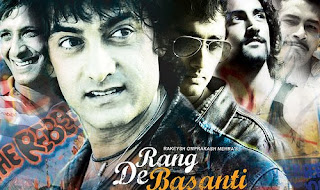
Rang de Basanti is a film about cycles. Time folds in upon itself and we encounter the modern generation of Delhi University Students suddenly living out the narrative of young revolutionaries of colonial times. When looking at Rang de Basanti, it’s important to consider the mechanisms instrumenting this folding of time, the role of youth culture today and it’s relationship to respective histories and politics, and the role of Sue and her camera.
The first image we see of Sukhi and DJ, as the camera rises up their bodies leaning backwards over perhaps a dam, is graphically similar to the images of the colonial revolutionaries that we just before saw being hung. The epic introduction suggests the revelation of Sue’s new revolutionaries until we realize they are chugging beers until one finally falls back, drunk, into the body of water below. Here the tension is revealed: our modern-day revolutionaries are too busy getting drunk. These “folds” or direct parallels of the past and present occur throughout the movie on different scales. In a sense, the movie is a guided dialogue with the past (through which the film inadvertently leads a dialogue on “what is the connection here?”)
The most apparent fold of time occurs when DJ and Chandrashekhar Azad both speak, yet now we are not simply dealing with flashbacks. The action is taking place in present day time. In response to Ajay’s death, which resulted from cheap airplane parts bought to save money for the corrupt government, DJ says “we must take drastic measures,” to which Sonia responds “Kill him.” The audience immediately knows her response. We’ve seen the conversation played out before, and we now realize the group’s fate. But I realize this notion of ‘fate’ is a western one, and the more appropriate understanding of this parallel is that the boys, and Sonia, begin to live out their dharma-- to succumb to their role in this incarnation of a ‘revolutionary cycle’ and to their duty to their country.
The realization of their dharma, however, does not occur immediately. The youth culture of the Delhi University is characterized by the typical night driving, rock ‘n roll and raging hormones that are characteristic of what the “Indian Popular Cinema, Nation, and Diaspora” article referred to as “MTV” culture. What’s more definitive about the generation though is their apathy towards politics, their loss of hope in the government and their loss of hope in themselves. Kshama Kumar’s article “‘Baghat Singh Topless, Waving in Jeans” discusses this disillusionment in therms of Freud’s “melancholia”-- defined by a loss of an ideal, and the loss of hope.
However, a transformation occurs. After watching a reenactment of Jallianwala Bagh, the students are in aw of their own history. They are learning and internalizing the words of revolutionaries, they are reliving the terror of their nation’s past. These activities are punctuated with Ajay’s death as a result of a corrupt government and the fuse is lit. The MiG airplane part protest turns into a parallel of Jallianwala Bagh and they have no other choice. Their ‘roles’, cinematically and realistically, have already been set out for them.
Also important though is to consider who designated these roles. Sue appointed them upon first seeing the boys. It is worth questioning what her authority is traveling to a foreign country with her grandfather’s diary and a nice camera with an assumed narrative already in place. It is possible, even likely, that this derives from a “white man’s guilt” complex. However, I’d like to pose the question of how should individuals deal with a guilt derived from the actions of their ancestors. We are living in a globalized, power-kegged society where many of our forefathers have offended other’s forefathers. Is reaching out to tell a story (even for the purpose of redemption) really that bad of a thing?
What is more problematic is that the narrative she sets up is absolutely crucial to the outcome of the story. The boys probably would not have shot the Minister of Defense had she not pointed out to them their own history. But we are proud of them because they are proud of themselves, they have found their identity and they feel complete in that. That is why the story does have a happy ending despite their passing. Sue introduces a camera, which in itself is a figurative eye. This eye is a representation of mindfulness-- mindfulness of the nation’s history and of their present actions. Perhaps the power in creating change is really just a matter of knowing someone is watching.
Baaghi 2 Full HD Movie Download
ReplyDeleteBaaghi 2 Full Movie Download
Baaghi 2 Movie Screen Cast
Watch Online Roadies Xtreme Episodes
Baaghi 2 Full HD Movie Download
Baaghi 2 Full Movie Download
Baaghi 2 Movie Screen Cast
Watch Online Roadies Xtreme Episodes
Baaghi 2 Full HD Movie Download
Baaghi 2 Full Movie Download
Baaghi 2 Movie Screen Cast
Watch Online Roadies Xtreme Episodes
Baaghi 2 Full HD Movie Download
Baaghi 2 Full Movie Download
Baaghi 2 Movie Screen Cast
Watch Online Roadies Xtreme Episodes
Baaghi 2 Full HD Movie Download
Baaghi 2 Full Movie Download
Baaghi 2 Movie Screen Cast
Watch Online Roadies Xtreme Episodes
Baaghi 2 Full HD Movie Download
Baaghi 2 Full Movie Download
Baaghi 2 Movie Screen Cast
Watch Online Roadies Xtreme Episodes